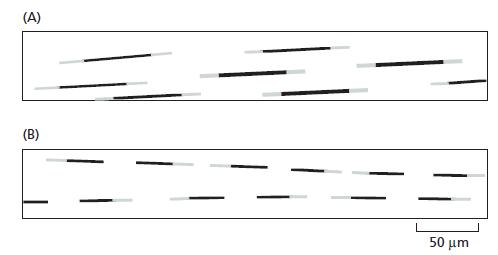You are investigating DNA synthesis in tissue-culture cells, using 3H-thymidine to radioactively label the replication forks. By
Question:
You are investigating DNA synthesis in tissue-culture cells, using 3H-thymidine to radioactively label the replication forks. By breaking open the cells in a way that allows some of the DNA strands to be stretched out, very long DNA strands can be isolated intact and examined. You overlay the DNA with a photographic emulsion, and expose it for 3 to 6 months, a procedure known as autoradiography.
Because the emulsion is sensitive to radioactive emissions, the 3H-labeled DNA shows up as tracks of silver grains. Because the stretching collapses replication bubbles, the daughter duplexes lie side by side and cannot be distinguished from each other.
You pretreat the cells to synchronize them at the beginning of S phase. In the first experiment, you release the synchronizing block and add 3H-thymidine immediately.
After 30 minutes, you wash the cells and change the medium so that the total concentration of thymidine is the same as it was, but only one-third of it is radioactive. After an additional 15 minutes, you prepare DNA for autoradiography.
The results of this experiment are shown in Figure Q5–2A. In the second experiment, you release the synchronizing block and then wait 30 minutes before adding 3H-thymidine. After 30 minutes in the presence of 3H-thymidine, you once again change the medium to reduce the concentration of radioactive thymidine and incubate the cells for an additional 15 minutes. The results of the second experiment are shown in Figure Q5–2B.
A. Explain why, in both experiments, some regions of the tracks are dense with silver grains (dark), whereas others are less dense (light).
B. In the first experiment, each track has a central dark section with light sections at each end. In the second experiment, the dark section of each track has a light section at only one end. Explain the reason for this difference.
C. Estimate the rate of fork movement (μm/min) in these experiments. Do the estimates from the two experiments agree? Can you use this information to gauge how long it would take to replicate the entire genome?
Figure Q5–2A & B

Step by Step Answer:

Molecular Biology Of The Cell
ISBN: 9780815344322
6th Edition
Authors: Bruce Alberts, Alexander D. Johnson, Julian Lewis, David Morgan, Martin Raff, Keith Roberts, Peter Walter




